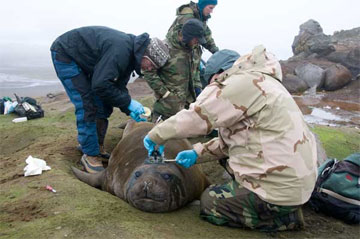Elephant seals go where no one has gone before: using seals for climate change research
Seals used for climate change research
Jeremy Hance, mongabay.com
August 11, 2008
|
|
Animals have aided humanity for millennia. We are used to considering animals like dogs, horses, cows, and lamas as utilitarian in a very direct way, but what about elephant seals?
As climate change presents a great threat to humanity and the world’s ecosystems, scientists are racing to collect the best information possible to understand the changes wrought by global warming. One area of the world that has been impossible to monitor is the sea-ice of Antarctica’s Southern Ocean. The inability of satellites to ‘see’ through the ice and the difficulty for ships in exploring them has made these regions a blank zone for climate change data. However group of researchers has found a way around these challenges. Ingeniously, they have attached oceanographic sensors to elephant seals that dive deep and feed among the sea ice.
The invaluable seals “provided a 30-fold increase in hydrographic profiles from the sea-ice zone,” the researchers write. In addition they allow “the major fronts to be mapped south of 60°S and sea-ice formation rates to be inferred from changes in upper ocean salinity.” The seals have the ability to dive 1500 meters and stay underwater for up to two hours.
 Mounting sensor on elephant seal. |
To study the data gaps, scientists tagged 58 elephant seals on four Antarctic islands. The seals swim distances of 35-65 kilometers (21-40 miles) in search of food, all the while taking important measurements of ocean salinity, temperature, and in some places sea-ice formation. Combing the conventional data provided by ships and satellites with the seal-collected information provide a far greater view of the Southern Ocean. “Elephant seals fill a ‘blind spot’ in our sampling coverage,” the authors write, “enabling the establishment of a truly global ocean-observing system.”
The researchers suggest that the same usage of elephant seals for climate data should be extended to other Antarctic predators, including other seal species. They argue that such data collection tactics have proven to be effective and affordable.
Elephant seals, with their characteristic long snouts, are strange and powerful animals. These blubberous behemoths can weigh between 2,000 and 6,000 pounds; the males are far larger than the females, with the largest male recorded reaching 11,000 pounds. Even their offspring are giants, at 265 pounds they are the equivalent of an adult Sumatran Tiger. The elephant seal—aptly named—is also the largest member of the order Carnivore, beating out the polar bear (the world’s largest land carnivore) by five times. Elephant seals feed on fish and squid, and have even been known to eat small sharks. During rutting season, the males become aggressive and often battle dramatically over breeding rights to large harems of up to 50 females. Hardly domesticable, these seals are proving invaluable none-the-less.
J.B. Charrassin, M. Hindell, S. R. Rintoul, F. Roquet, S. Sokolov, M. Biuw, D. Costa, L. Boehme, P. Lovell, R. Coleman, R. Timmerman, A. Meijers, M. Meredith, Y.H. Park, F. Bailleul, Y. Tremblay, C.A. Bost, C. R. McMahon, I. C Field, M. A. Fedak, and C. Guinet. (2008). Southern Ocean frontal structure and sea-ice formation rates revealed by elephant seals PNAS Online Early Edition for the week of August 11-15, 2008.